Sharp Travel & Tours Inc.
Contact Info
Telephone - 847.759.8813
Toll Free - 1.888.To.Sharp
Email - sharptour@hotmail.com
Popular Destinations
STANDARD GROUP TOURS
DAILY EXCURSIONS
AMT RECOMMENDATIONS

Just like Changdeokgung Palace was the residence of the royal court of Korea, Insa-dong was home to the aristocracy and public officials working for the king. After the end of the Joseon Dynasty, antique shops opened and sold the possessions of fallen aristocrats and noblemen. Numerous galleries soon followed, exhibiting and selling art. Today, the area is an established street of tradition and art, where local people and international tourists come to browse and buy.
If you want to treat yourself to traditional Korean cuisine, try one of the restaurants in the area. Many serve hanjeongsik (traditional Korean set meal) in a hanok building, offering great food in a quiet and traditional ambience. The price is not too pricey either. Lunch specials range from 5,000 to 7,000 won, while dinner costs between 10,000 and 15,000 won. Most of these traditional restaurants can be found along the narrow side streets off the main road. Restaurant signs are located at the entrance to these narrow streets, so look for any restaurant you have in mind.
More than anywhere else, Insa-dong is the best place to buy souvenir gifts. High-end design items and the widest variety of souvenirs are available, attracting both foreign and Korean shoppers. You can find three information centers here, one at each end of the main street and one in the middle. The centuries-old streets are narrow and labrynthine, so we recommend getting a map before sightseeing.
The street from Jongno 3-ga to Jongak is lined with foreign language institutes, shopping centers, wholesale jewelry stores, coffee shops, and restaurants that cater to the needs of young clientele. From Insa-dong to Jongno and then to Cheonggyecheon Stream is a mere 10-minute walk. There is an interesting story behind Cheonggyecheon Stream. The miraculous economic development of Korea in the 1970s spurred the construction of new roads and bridges, and for decades, the stream had been covered by concrete. After more than two years of renovation, it was unveiled on September 30, 2005. Today, it is the most talked-about tourist destination in Korea. The total length is 5.8 kilometers and the water is clean. Spanning the stream are twenty-two beautifully designed bridges, and during lunch time, the area is filled with office employees sipping take-out coffee or enjoying a leisurely walk. In the evening, the stream area is perfect for meeting a date or sightseeing. At night, colorful illuminations provide an array of fascinating sights.
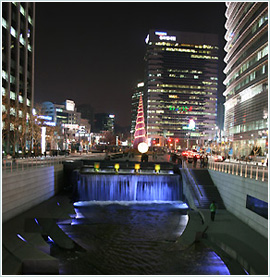
In Myeong-dong, you can feel the vibrance and fashion sense of Korea. On the one hand, you can see young ladies walking together hand in hand (they are not lesbians) looking at the vending stalls full of accessories or taking off their shoes to try on a pair of inexpensive shoes that may be pretty, but will probably not last long. On the other hand, you’ll find shoppers loaded down with luxury-brand shopping bags like Polo or Gucci. There is even a shop selling T-shirts, socks, cups, and other souvenir items with printed images of Hallyu stars. Many Japanese tourists visit the area, and restaurant signs written in Japanese appear on every corner.
In short, there is almost nothing you can’t find in Myeong-dong. While most shops sell clothing, accessories, shoes, and cosmetics, there are also many restaurants and coffee shops. It is best to go to Myeong-dong after 5pm, when there are more street vendors selling their own hand-crafted items or products bought from wholesalers or other stores.
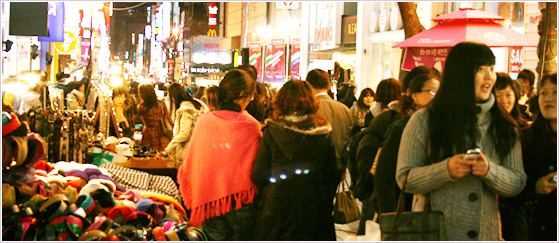
ANNUAL FESTIVALS
INSADONG
CHEONGAYCHON STREAM
MYEONG-DONG

SEOUL ATTRACTIONS
Changdeokgung Palace is the second royal villa built after Gyeongbukgung Palace in 1405. Chandeokgung served as the principal palace by many Joseon kings an remains the best preserved among the five royal Joseon palaces. The rear garden that was used as a place of rest by the kings boasts a gigantic tree that is over 300 years old, a small pond, and a pavilion. The palace grounds are comprised of a public palace area, a royal family residence building, and the rear garden.
CHANGDEOKGUNG PALACE
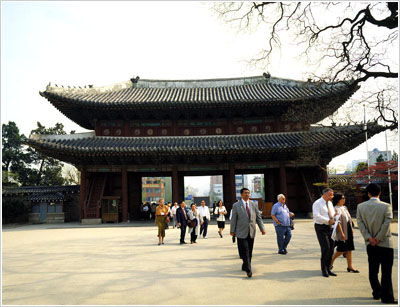
The palace served as the main building after the 9th king of Joseoun, Seongjong, when a number of kings used this palace as a place of dwelling. However, the palace was burned down during the time of the Japanese Invasion of Korea in 1592. Angry citizens set fire to the palace when it was evacuated during the time of invasion. Thanks to Gwanghaegun, the palace was later restored in 1611, where nature and art now flourishes, quite a sight to see for tourists. The palace is filled with cultural assets such as Injeongjeon Hall, Daejojeong Hall, Seonjeongjeon Hall and Nakseonjae to visit.
The World Cultural Heritage Committee also designated Changdeokgung Palace as a World Cultural Heritage in December of 1997 in Napoli, Italy.
Changdeokgung’s rear garden was constructed during the reign of Taejong, and had served as a resting area for the royal family members. The garden was also called Bukwon and Geumwon, but after Kojong became king, he renamed it Biwon. The garden was kept as natural as possible and human hands were only used when absolutely necessary. Buyongjeong, Buyongji, Juhabru, Eosumun, Yeonghwadang, Bullomun, Aeryeonjeong, and Yeongyeongdang are some of the many pavilions and fountains that occupy the gardens. The most beautiful time to see the garden is during the fall when the autumn foliage is at its fullest peak and the leaves start to fall.
If you get off at Chungmuro Subway Station, you are right in front of Namsangol Hanok Village(traditional Korean village). You may consider it interesting to find this area standing between the tall buildings. This village has restored five traditional Korean houses, with a pavilion, a pond and a time capsule which makes it a perfect spot to take a walk.
When you enter the front gate, you will see the vast valley and the Chunugak to the left of the pond. Along with the pond, it is a splendid place where performances are held. On the side you will see five traditional houses.
NAMSAN HANOK VILLAGE
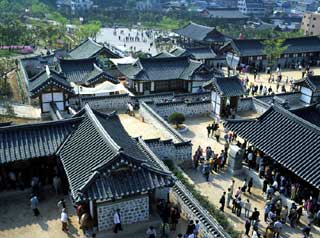
These houses were rebuilt after the traditional houses of Joseon Dynasty. The houses belong to various social ranks of the society from peasant to king. The furniture in the house are situated to help guests understand the daily life of the past. The clean traditional houses and used home equipments are great to take pictures. If you would like to see souvenirs, stop at the traditional craftwork exhibit where you can buy small dishes and souvenirs. You can also have traditional tea and refreshments. On the grounds, there are traditional games you may want to try such as 'neolttwigi' (sea-saw jumping), 'tuho'(arrow throwing) and 'yunnori' (traditional game of throwing wooden yut sticks). In addition, you may not want to miss traditional marriage ceremony. During the weekends, traditional marriages are shown at Bak Yeong Hyo's Residence. The traditional marriage ceremony is an interesting event for both Koreans and foreigners and many gather to watch although it is not shown at certain hours. During the winter season (November to February), there are not many weddingceremonies held, as it is frequently held in Spring and Fall. Hours for the ceremony are held around noon or 1 p.m. Visitors can take pictures with husband and wife wearing traditional wedding costumes. Furthermore, there is also a time capsule in remembrance of Seoul’s 600 Year Anniversary. Buried in 1994, it is anticipated to open four hundred years later.
Located at the corner of the busiest intersection of downtown Seoul, Deoksugung Palace is famous for its elegant stone-wall road. It is the only one that has western buildings beside it, and it adds to the uniqueness of the scenery. Deoksugung Palace originally belonged to Wolsandaegun (1454~1488), the older brother of King Seongjong (1469~1494) of the Joseon Dynasty. It became a proper palace when Gwanghaegun (1575~1641) ascended the throne and gave the palace the name Gyeongungung in 1611. Afterwards, the name was changed to Deoksugung.
DEOKSUGUNG PALACE

Enter Deoksugung Palace and Daehanmun, and Geumcheon appears, with the Geumcheon bridge, wide enough for the king’s carriage to pass. The Beopjeon Building Junghwajeon is very stately, revealing of its long history. The Jeukjodang Building received its name from Gwanghaegun and In-Jo both ascended to the throne here. The front sign on Jeukjodang was written personally by Go Jong in 1905 after he became king. Hamnyeongjeon was where Go Jong slept, and Hamnyeong was named so to wish Go Jong lasting peace. The East Wing served as the King’s room, and the west wing was for the Queen. Jeonggwanheon was the first western style building built in the palace in 1900. Go Jong enjoyed drinking coffee and spending his free time here. The back of the building had secret passageways to the Russian Emissary, which still exist today.
Seokjojeon is the other western-style building that still remains in Gyeongwungung, and it was in the process of being built by a British man for his company when in 1905 the property rights became that of Japan. It was finally completed in 1910. After Gojong’s death, Seokjojeon became a Japanese art gallery and open to public, and after Korean Independence, the American-Russian joint commission was held here as well in May 1946. The east wing of Seokjogwan building now serves as a Palace Treasure exhibition, and the west wing is used as part of National Modern Arts
Established in 1395, Gyeongbokgung Palace is also called “Northern Palace” because it is located more toward the north compared to Changdeok Palace (Eastern Palace) and Gyeonghee Palace (Western Palace). Gyeongbok Palace is arguably the most beautiful and remains the most comprehensive and grandest of all the five palaces. It was destroyed by a fire during the Japanese Invasion of Korea during 1592-1598. However, all of the palace's 7,700 rooms were later restored under the leadership of Heungseondaewongun in the years of King Gojong (1852~1919).
GYEONGBOKGUNG PALACE
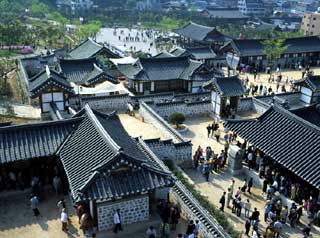
In the Gyeongbok Palace, the most representative edifices of the Joseon Dynasty, Gyeonghoe-ru Pavilion and Hyangwonjeong Pond still remain. Woldae and sculptures of Geunjeongjeon (The Royal Audience Chamber) represent the past sculpture art which was the trend back then.
The National Palace Museum of Korea is located south of Heungnyemun Gate, and the National Folk Museum is located east within Hyangwonjeong.
*Ticket passes for Gyeongbok Palace can also be used at the National Palace Museum and the National Folk Museum.
.

POPULAR DESTINATIONS
© 2008 Sharp Travel and Tours Inc.
